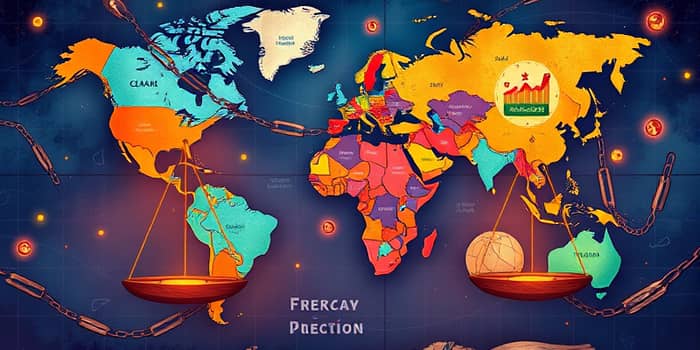As governments and societies grapple with the aftermath of the pandemic era, the world stands at the brink of a fiscal precipice. Global public debt has surged to unprecedented levels, fueling debates about sustainability, growth, and equity. Understanding the magnitude and nuances of this challenge is essential for policymakers, investors, and citizens alike.
Global Overview: The Expanding Mountain of Debt
In 2024, total public debt across the globe reached an eye-watering $102 trillion, marking a $5 trillion increase from the previous year. When corporate and household obligations are included, total global debt climbed past $324 trillion by Q1 2025, up $7.5 trillion in just twelve months. This unprecedented debt expansion across all sectors has been driven by a blend of emergency stimulus measures, ongoing fiscal deficits, and persistent economic headwinds.
Developed, emerging, and low-income economies have all felt the strain. Advanced nations leaned heavily on stimulus programs to maintain consumption and protect labor markets. Meanwhile, emerging economies, grappling with slower recovery and tighter financing conditions, have seen borrowing costs soar. Low-income countries, already vulnerable, face the stark choice between servicing debt and funding essential services.
Debt-to-GDP Ratios: Mapping the Pressures
Debt-to-GDP ratios offer a lens into how countries manage their obligations relative to economic output. The global average for advanced economies stands at 110%, while emerging markets average 74%. Yet the extremes reveal more dramatic stories of crisis and resilience.
Lebanon and Sudan top the chart, hampered by conflict, hyperinflation, and institutional fragility. Japan’s ratio reflects decades of stimulus against stagnation and an aging society. The United States, while possessing the largest absolute debt at $32.9 trillion, maintains a lower ratio, buttressed by reserve currency status and robust financial markets.
Roots of the Crisis: Key Drivers of Debt Accumulation
Multiple forces have converged to push global debt to stratospheric levels. Identifying these drivers helps clarify potential policy responses and risk management strategies.
- COVID-19 Pandemic Fiscal Support: Emergency spending on healthcare, unemployment benefits, and business loans propelled deficits.
- Geopolitical Instability and Conflict: Wars, sanctions, and trade disruptions have strained budgets in both combatant and neighboring states.
- Persistent Economic Slowdowns: Stagnant growth reduces tax revenues and necessitates further borrowing.
- Structural Demographic Challenges: Aging populations and legacy financial crises demand higher social spending.
Impact and Consequences: A Strained Global Economy
The repercussions of mounting debt manifest differently based on a nation’s development level. While some countries can borrow cheaply, others face steep refinancing costs and market exclusion.
- Developed Nations Crowding-Out Investment: Higher borrowing costs can divert capital away from innovation and infrastructure.
- Developing Countries’ Tough Choices: Many must balance debt service against funding health, education, and other critical services.
- Rising Net Debt Outflows: The number of nations sending more capital abroad to meet obligations has doubled in ten years.
- Default and Market Exclusion Risks: Unsustainable ratios threaten credit downgrades, social unrest, and loss of access to international financing.
Debt Instruments and Emerging Market Trends
Sovereign bond markets remain the primary vehicle for government financing. OECD projections estimate sovereign bond issuance will hit $17 trillion in 2025, up from $14 trillion in 2023. This surge reflects both refinancing needs and ongoing deficits.
Emerging markets have increasingly turned to external borrowing. With global interest rates on the rise, refinancing terms have tightened, raising the specter of rollover risk. Meanwhile, corporate and household debt also ballooned, fueled by low-rate environments earlier in the decade.
Sectoral analysis underscores that government, corporate, and household segments are all contributors to the total $324 trillion threshold. Each carries its own vulnerabilities: currency mismatches in corporate bonds, inflated asset prices from household credit, and political pressures on sovereign lending.
Policy Pathways: Reform and Solutions
Addressing the debt dilemma requires coordinated action at domestic and international levels. No single solution can restore balance, but a combination of measures can mitigate risks and promote sustainability.
- Reforming International Finance Architecture: Advocates call for development-oriented frameworks that better serve vulnerable economies.
- Global Debt Workout Mechanisms: A unified approach to restructuring could reduce costs and prevent chaotic defaults.
- Enhanced Liquidity and Concessional Finance: Faster, targeted support for nations facing acute refinancing pressures.
- Climate Transition Financing: Leveraging debt markets to fund sustainable infrastructure and low-carbon projects.
Charting a Sustainable Path Forward
The historical arc of global debt since 2008 reveals cycles of crisis and recovery. Post-2008 stimulus lifted economies but planted seeds of future liability. The pandemic exacerbated these trends, leaving a legacy of elevated borrowing.
Country case studies offer lessons. Japan’s long struggle with deflation and aging highlights the limits of monetary policy. The United States’ political gridlock complicates fiscal decision-making. And fragile states like Lebanon and Sudan underscore how conflict and institutional breakdown can amplify debt burdens beyond manageable levels.
International institutions such as the IMF, World Bank, and UNCTAD have proposed policy agendas focused on debt transparency, early warning systems, and more inclusive decision-making. These initiatives aim to enhance resilience and ensure that borrowing supports long-term development.
At its core, the global debt dilemma is a balancing act between growth and sustainability. Fiscal discipline must be weighed against the need for stimulus and social investment. Effective solutions will hinge on collaboration, innovation in financial instruments, and a willingness to confront difficult trade-offs.
Ultimately, the world must decide whether it can manage the burden of unsustainable debt accumulation or whether it will be forced into widespread restructurings and austerity. The stakes are high: decisions made today will shape economic prospects, social welfare, and geopolitical stability for generations to come.
Conclusion: Embracing Collective Responsibility
Debt dilemmas are not just numbers on a ledger—they represent the hopes, challenges, and futures of billions of people. By embracing bold policy reforms and international cooperation, we can transform a mounting crisis into an opportunity for sustainable growth. The path is complex, but with informed action and shared commitment, the global community can navigate this balancing act and secure a more resilient, equitable future.
References
- https://www.visualcapitalist.com/visualized-government-debt-around-the-world/
- https://worldpopulationreview.com/country-rankings/countries-by-national-debt
- https://www.oecd.org/en/publications/2025/03/global-debt-report-2025_bab6b51e.html
- https://www.iif.com/Products/Global-Debt-Monitor
- https://www.worldbank.org/en/programs/debt-statistics/ids
- https://unctad.org/publication/world-of-debt
- https://www.iif.com/Key-Topics/Debt/Monitors










